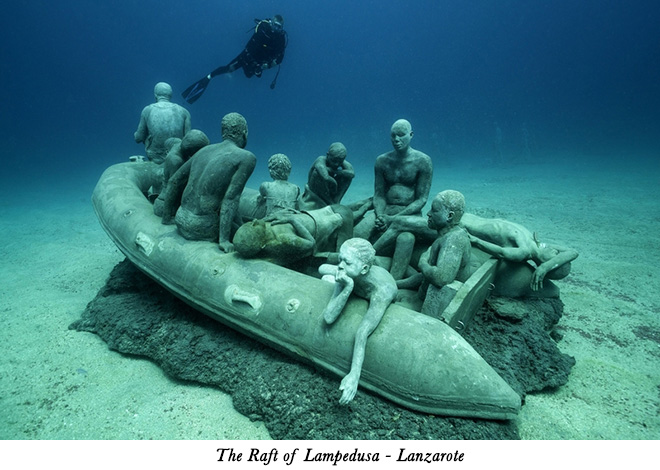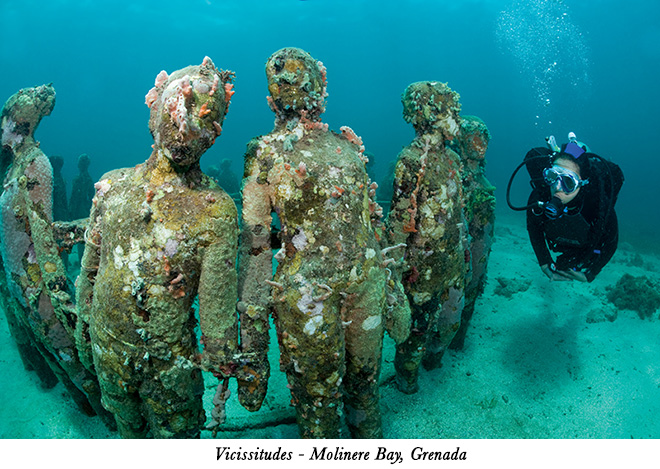Underwater Statues and Sculpture ParksContents of this Issue: Dewi Nusantara, Komodo, Indonesia Sick Divers, Macho Divemasters Flying After Diving, Researchers Need Your Help G’day Mate, Do You Want A Lift? Underwater Statues and Sculpture Parks When Your Liveaboard Doesn’t Go Where It Promised Stop Using Aqua Lung Powerline Inflators Immediately! Equipment Issues from our Readers When Great White Cage Dives Go Awry An American Immersion: The First Woman To Dive All 50 States Editorial Office: Ben Davison Publisher and Editor Undercurrent 3020 Bridgeway, Suite 102 Sausalito, CA 94965 visit an art gallery while diving from the November, 2016 issue of Undercurrent
It probably all started at Portofino in Italy, where, in 1947, pioneer Italian diver Dario Gonzatti lost his life. Honoring his life, there now stands a bronze stature of Christ, eight feet tall in only 30 feet of water. It was created by Italian sculptor Guido Galletti and is a popular attraction for scuba divers and free divers alike. Galletti's mold bore two more statues. One is at the surface in Grenada's harbor, in remembrance of the death of a crewmember when an explosion and fire hit Italian liner Bianca C. in St. George's harbor in 1961. Still on fire, it was towed into deeper water, where it sank and is now a popular dive site. The other is in the John Pennekamp Coral Reef State Park, 25 feet deep in the water off Key Largo. www.floridakeys.com/keylargo/pennekamp.htm In 1990, another 10-foot-high statue of Jesus was placed 30 feet deep, between the Mediterranean islands of Malta and Gozo, to commemorate the visit of Pope John Paul II to Malta. There's a much smaller statue of a dolphin placed at the entrance to an underwater cave in the Medas Islands, a popular diving spot in Spain. What started as an initiative to deter dynamite fishing resulted in an underwater destination for a pilgrimage. In 2010, a 12-foot-tall representation of the Virgin Mary with baby Jesus was erected on the seabed at the Bien Unido Double Barrier Reef Marine Park in Bohol in the Philippines. www.bohol-philippines.com/underwater-grotto-shrine.html There's a Guardian of the Reef merman statue just outside the Divetech dive shop in Grand Cayman that is twinned with one at Sunset House, which has its own mermaid statue of Amphitrite around 50 yards from the shore and 45 feet deep. www.guardianofthereef.com/ The largest underwater statue must be the Ocean Atlas. This 60-ton figure, sculpted by British/ Guyanan artist Jason deCaires Taylor, is said to symbolize the greater need for ocean conservation and ironically can be found close to an oil refinery in New Providence, in the Bahamas. It's rivaled in size only by the abandoned fake moai, a stoical 22-foottall monolith lying against the reef, that mirrors the monoliths on shore in Easter Island but was actually made for a less-than-successful Kevin Costner movie, Rapa-Nui, in 1994. None of these can compare with the statue park conceived and sculpted by Taylor in Grenada. 'Vicissitudes' is the name of an installation placed in Molinere Bay in 2006. This collection of life-sized figures of schoolchildren arranged in a circle has since been joined by other similar installations. There's the 'Lost Correspondent' at a desk complete with a typewriter as well as other interesting figures, and not to be outdone in the religious category, the park now also has its own 'Christ of the Deep.' The idea was first mooted after Hurricane Ivan and Hurricane Emily destroyed much of Grenada's coral reefs in 2004 and 2005. Already, the statues have attracted sponge growth and a healthy nudibranch population. Recently, a local artist has added new works to the sculpture park. Even that pales into insignificance with Taylor's array of 500 life-sized figures that comprise an underwater installation, 'Silent Evolution,' at the Museo Subacuatici de Art in the waters off Cancun, Isla Mujeres and Punta Nizuc in Mexico. For example, 'Inertia' is an overweight naked man sitting on a sofa with a plate of fast food, watching television. This work was conceived in 2009 and draws some 750,000 visitors annually, away from the area's natural reefs toward an otherwise featureless seabed.
Not to be outdone, on the other side of the Atlantic, Jason deCaires Taylor was commissioned and created another sculpture park off the coast of Lanzarote, in the Canary Islands. It represents desperate refugees from Africa and selfie-taking tourists. The Museo Atlantico includes Taylor's 'The Raft of Lampedusa,' a sculpted inflatable boat carrying 13 refugees and a modern take on Géricault's 1818 painting, 'The Raft of the Medusa.' The full installation will be completed this year, but the raft is expected to be joined by a faceless couple taking a selfie, people glued to their phones and others brandishing iPads or wielding cameras. The artist calls it 'the Instagram generation.' www.underwatersculpture.com Taylor doesn't have a monopoly on underwater sculpture. Val, with her husband Frédéric Morel, is a French-born sculptor living in Thailand. She has recently installed three large sculptures near Koh Tao. Called 'Ocean Utopia,' it was completed in cooperation with an NGO specializing in the conservation of coral reefs. Already marine life is finding it an inviting underwater habitat. www.sculptureval.com In Austria, an otherwise uninviting freshwater lake hosts the somewhat bizarre Grublsee Alpen Aquarium which features replica ancient artifacts submerged in its depths including Egyptian tombs, old cannons and Buddhist statues alongside quirky pieces like a miniature Statue of Liberty, Christ the Redeemer, aliens and skeletons. During the winter it is inaccessible to divers thanks to the snow and ice, when a rustic ski hut is the only attraction. Gambling with the stakes to be the most bizarre, back in the USA, a former NYC environmental 324-foot tanker ship has been sunk in 120 feet of water off Pompano Beach, FL. Unlike the many other wrecks purposefully sunk along this coast for the benefit of divers, Lady Luck features work by noted Greater Fort Lauderdale artist Dennis MacDonald, who was hired to create several fun and fanciful displays, including a faux casino for the ship deck, which features poker tables, slot machines, a cascade of gigantic dice, an octopus craps dealer, card sharks and a mermaid cocktail waitress. One of the largest contributions to Florida's artificial reef system, it is intended to be the centerpiece of what will become Shipwreck Park and is expected to draw 35,000 divers annually. www.southfloridadiving.com With coral reefs seemingly in trouble worldwide, one day we may be grateful for sculpture parks as a habitat for marine life and as unique places for divers and photographers.
Life mimics art and art mimics life. In an aim to call attention to the marine environment partly as a call for better conservation, artist Doug Aitken built an ambitious installation on the floor of the Pacific near Avalon, Catalina Island, to coincide with his exhibition at the Museum of Contemporary Art. Scuba divers can swim through a series of underwater structures. 'Underwater Pavilions', composed of three geometric sculptures with partly mirrored exteriors moored at depths between five and 50-feet. It caused a sensation in the art world. Although this installation is said to be temporary (but with no end date yet decided), Aitken hopes for a permanent installation erected in Venice, Italy, during 2017. |

I want to get all the stories! Tell me how I can become an Undercurrent Online Member and get online access to all the articles of Undercurrent as well as thousands of first hand reports on dive operations world-wide
| Home | Online Members Area | My Account |
Login
|
Join
|
| Travel Index |
Dive Resort & Liveaboard Reviews
|
Featured Reports
|
Recent
Issues
|
Back Issues
|
|
Dive Gear
Index
|
Health/Safety Index
|
Environment & Misc.
Index
|
Seasonal Planner
|
Blogs
|
Free Articles
|
Book Picks
|
News
|
|
Special Offers
|
RSS
|
FAQ
|
About Us
|
Contact Us
|
Links
|
3020 Bridgeway, Ste 102, Sausalito, Ca 94965
All rights reserved.



